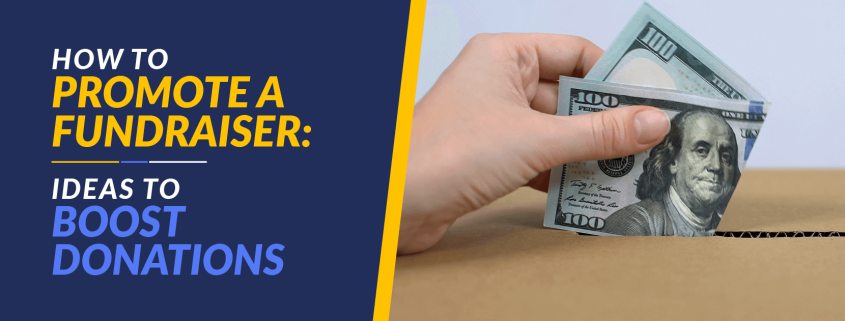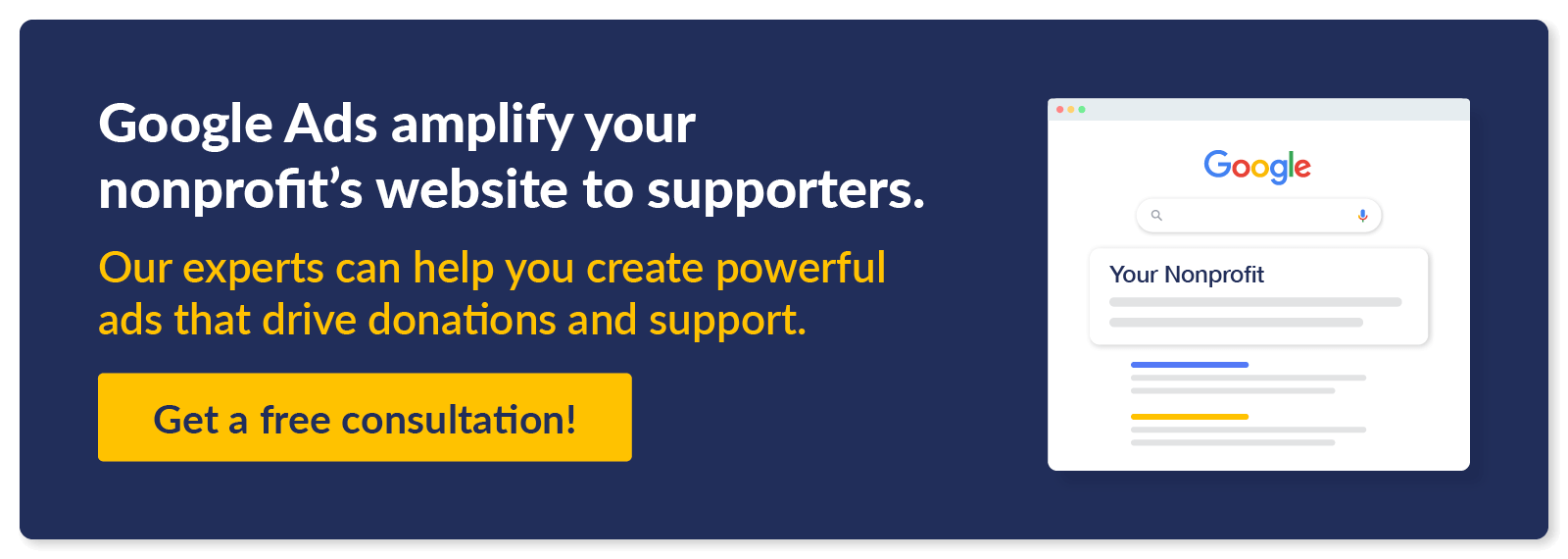How To Promote a Fundraiser: 10 Ideas To Boost Donations
A successful fundraiser doesn’t just happen. It needs strong promotion to attract donors, rally supporters, and build momentum. Whether you’re hosting an in-person event, a digital fundraising campaign, or a grassroots effort, getting the word out is essential.
Reaching the right audience and inspiring them to take action requires a thoughtful strategy and the right marketing techniques. But with new marketing platforms and donor engagement strategies popping up each year, how do you ensure your fundraiser stands out? This guide will walk you through the essentials of how to promote a fundraiser using both digital and offline methods. We’ll cover the following:
- Types of Fundraisers to Promote
- The Elements of Successful Fundraiser Marketing
- How To Promote a Fundraiser
- Examples of Successful Fundraiser Marketing
No matter what type of fundraiser you’re running, effective promotion requires planning and strategy. It’s easy to feel overwhelmed by all the moving parts, but the right approach can set you up for success.
Types of Fundraisers to Promote
Knowing how to promote different types of fundraisers is key to maximizing engagement and reaching the right audience. Fundraisers come in many forms—some rely on in-person events and community participation, while others leverage digital platforms to reach a wider network of supporters. Whether you’re promoting your donation page or inviting people to charity run, each type requires a tailored marketing approach to ensure success.
Let’s explore the most common types of fundraisers to promote.
Nonprofit Digital Fundraising Campaigns
A nonprofit digital fundraising campaign is a strategic fundraising effort conducted online to achieve a specific goal within a set timeframe. It leverages digital fundraising tools and online marketing channels to engage supporters, collect donations, and maximize impact.
With over 5.5 billion internet users worldwide, your potential donors are just a click away. A well-planned digital fundraising campaign that’s promoted effectively can make your nonprofit experience the following benefits:
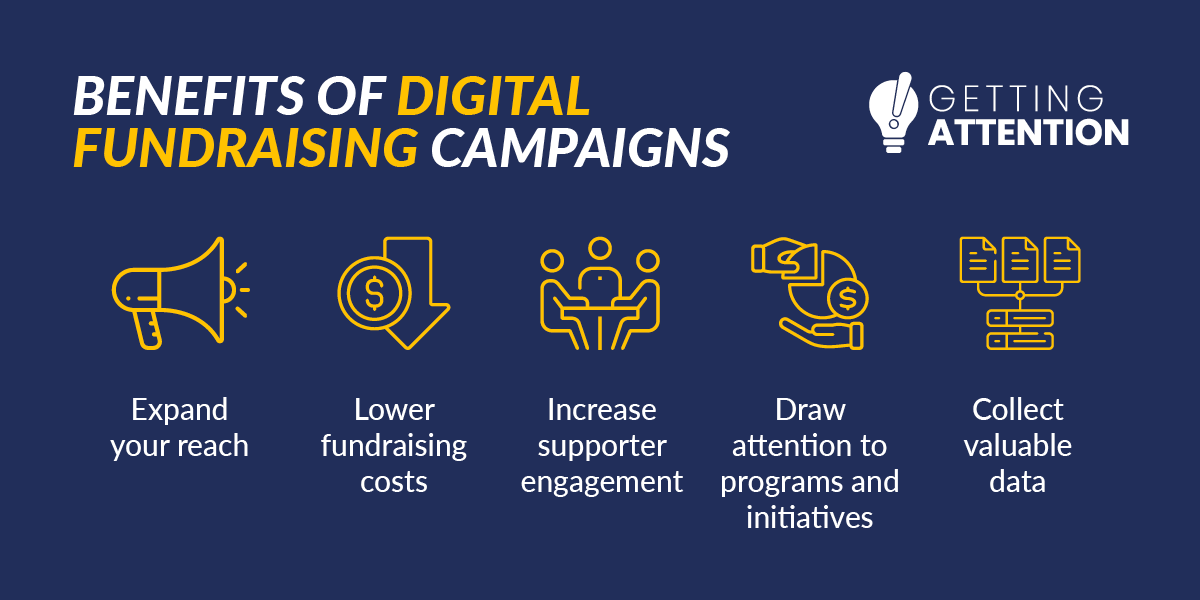
- Expand your reach and raise awareness. Digital fundraising campaigns help share your mission across multiple online channels, reaching supporters worldwide. Potential donors everywhere can engage with your content and give to your campaigns, helping you form relationships with diverse supporters.
- Lower fundraising costs. Often, digital fundraising campaigns have lower overhead costs than in-person campaigns. In-person fundraising often involves renting an event venue, purchasing print materials, and paying other costs that aren’t necessary for digital fundraising.
- Increase supporter engagement. Nonprofit digital fundraising campaigns often occur over a long period of time and involve activities that encourage long-term involvement. With a digital fundraising campaign, your supporters have the opportunity to play a huge role in your success and marketing potential by reposting your messages and directing friends and family to your donation page.
- Draw attention to programs and initiatives. Nonprofits often raise funds for specific needs. Launching a digital fundraising campaign can be the perfect conduit for raising funds for specific programs and projects to help your beneficiaries.
- Collect valuable data. An important part of fundraising is seeking opportunities and information to improve your nonprofit’s future campaigns. With digital fundraiser marketing, you can easily collect and analyze data to assess what you can do better for your next campaign. Over time, you’ll find that your digital fundraising campaigns generate greater impact.
While the main goal of a digital fundraising campaign is to generate revenue, you can also raise awareness of your mission and build your reputation along the way. Digital fundraising campaigns can do wonders for your mission and your nonprofit’s larger public image. You just need to use the right fundraiser marketing tools to power these fundraisers.
Fundraising Events
Fundraising events are a powerful way to engage supporters, build community, and generate donations. Whether in-person, virtual, or hybrid, events create opportunities for interaction and storytelling that inspire giving.
Popular types of fundraising events include:
- Galas. These high-energy gatherings can attract major donors and adapt to fit either the virtual or offline space. Host additional fundraising activities like raffles, and encourage online engagement by livestreaming entertainment and speakers. By offering online options, you’ll sell even more tickets than you would for an in-person event since people can attend from any location.
- Auctions. Auctions give donors fun prizes in exchange for their contributions. Procure high-value items to auction off and invest in a remote auction tool that allows attendees to conveniently bid on items they’re interested in if you’ll allow online participation. You can even promote your fundraiser by posting unique or valuable items to your social media pages.
- Walkathons and runs. Bring your community together with a charity run. Encourage supporters to participate in fundraiser promotion by adding a peer-to-peer fundraising element. They’ll create personal fundraising pages and encourage their friends and family to give in support of their participation.
- Webinars or panels. Invite nonprofit leaders and experts to discuss topics related to your digital fundraising campaign. Allow attendees to ask questions directly through a live chat. Some guests will be more inclined to participate this way since speaking to a crowd virtually may be less intimidating than asking a question in front of a large in-person audience.
No matter what event you’re hosting, active fundraiser marketing is key. Use social media, email marketing, and community outreach to boost attendance. You can even encourage supporters to invite their loved ones to expand your event’s reach.
Ongoing Giving Programs
Ongoing giving programs provide nonprofits with a steady stream of donations, often through recurring contributions or membership-based fundraising. Consistently promoting fundraisers that are continuous is essential for growth.
Common types of giving programs include:
- Monthly giving programs. Supporters commit to automated, recurring donations, creating a reliable revenue stream.
- Sponsorship programs. Donors support specific initiatives, such as sponsoring a child, animal, or community project.
- Corporate partnership programs. Companies provide financial support in exchange for public recognition, such as their logo on a corporate sponsor page on your nonprofit’s website.
- Peer-to-peer fundraising. Supporters raise funds on behalf of your nonprofit by creating personal fundraising pages. This puts fundraiser promotion in their hands.
You can promote fundraising programs like these through targeted email campaigns and social media to highlight long-term impact. If you feature them on your website, paid ads are also a great way to promote these fundraisers.
The Elements of Successful Fundraiser Marketing
Successful fundraiser marketing requires a strategic approach to drive donations. From crafting compelling messaging to choosing the right channels, every element plays a role. Let’s explore the key components of an effective fundraiser marketing strategy.
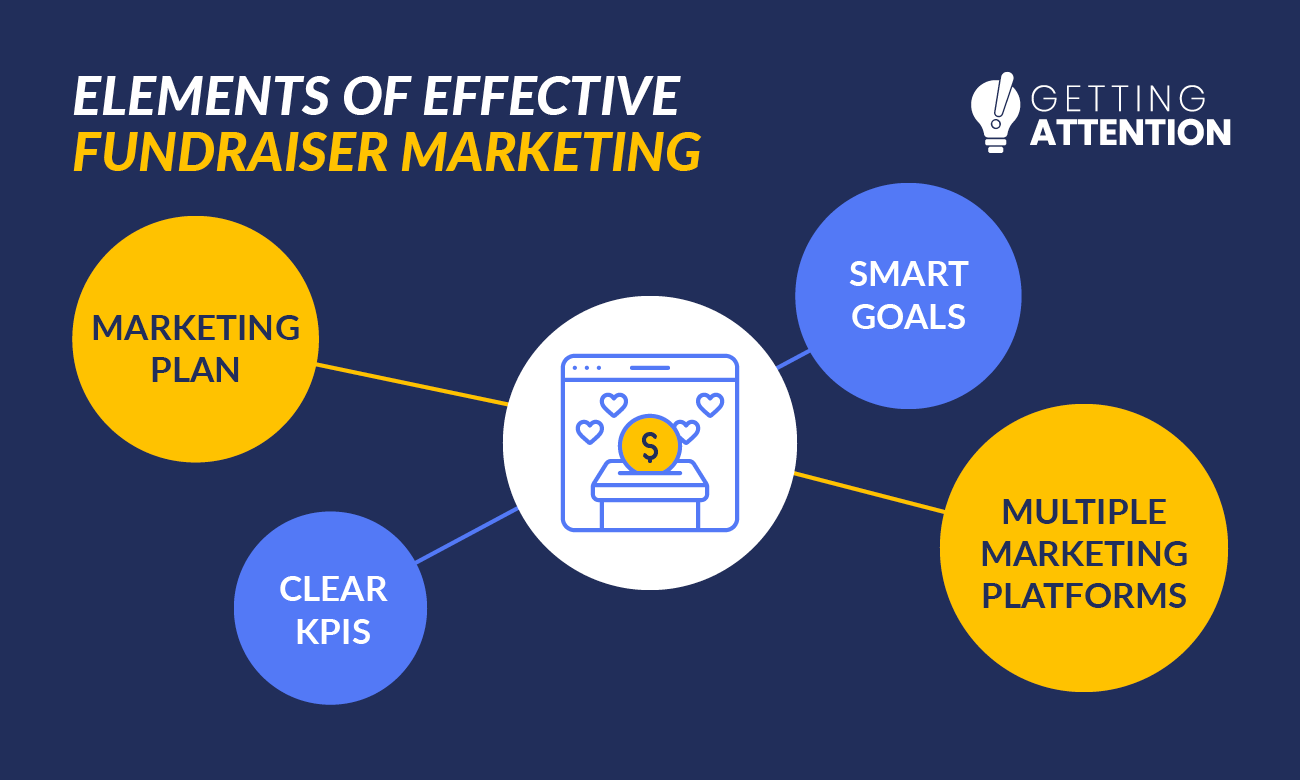
A Strong Nonprofit Marketing Plan
Even engaging fundraising ideas will fall short if not promoted effectively. A clear, comprehensive marketing plan ensures your team is clear on messaging and timing. Include these elements in your fundraiser marketing plan:
- Effective messaging: Craft compelling, mission-driven messaging that resonates with your audience and inspires action. You’ll want to gather stories that focus on the donations and the people who benefit from your work.
- Marketing materials. Develop high-quality content, including emails, social media posts, flyers, and videos, to support your campaign.
- Clear target audience. Define who you’re trying to reach and tailor your messaging accordingly. Segment donors based on giving history, demographics, and engagement levels to ensure more personalized and effective outreach.
A well-structured marketing plan gives your fundraiser the direction needed to engage supporters and drive donations.
SMART Goals
Set a firm foundation for your campaign by setting well-defined goals. We recommend using the SMART goal framework:
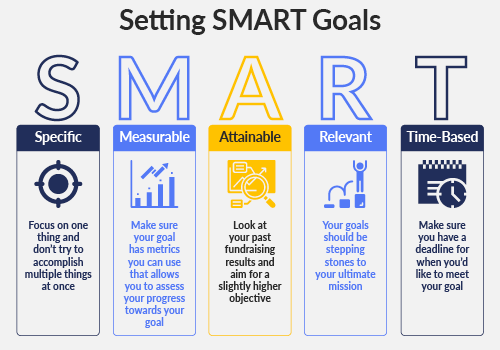
- Specific: Clearly outline what you want to accomplish, including the who, what, where, and why of your goal.
- Measurable: Define success with quantifiable metrics, such as a donation target or number of new donors.
- Attainable: Set a realistic goal based on your resources, capacity, and past performance.
- Relevant: Ensure your goal aligns with your nonprofit’s mission and fundraising needs.
- Time-Based: Establish a deadline to create urgency and hold your team accountable.
Let’s say you’re hosting a fundraising gala. Here’s what your SMART goal might look like:
“Sell 500 tickets and raise $50,000 for our annual charity gala by the end of the event through targeted email campaigns, social media ads, and corporate sponsorships.”
Essentially, be realistic about what you can achieve, but push your team. If you have multiple priorities for your fundraiser, create different goals and list them in order of priority to focus your fundraiser marketing.
Effective Key Performance Indicators
After determining your campaign goals, consider the key performance indicators (KPIs) you’ll use to measure success. Examples include:
- Total Funds Raised: The total amount of money collected during the campaign
- Donation Conversion Rate: The percentage of visitors who donate after viewing your campaign page (especially crucial for digital fundraising campaigns)
- Ad Click-Through Rate: The percentage of people who click on your fundraiser’s ad after seeing it, indicating how relevant your ad is to viewers
- Average Donation Amount: The average contribution size per donor
- New vs. Returning Donors: The ratio of first-time donors to repeat supporters
- Email Open and Click-Through Rates: Engagement with email campaign promoting your fundraiser
- Social Media Engagement: Likes, shares, comments, and reach of promotional posts
- Event Attendance: The number of participants for fundraising events
For instance, one of your goals might be to increase the matching gifts you receive online by sharing educational materials. You might measure your digital fundraising campaign’s success based on the number of donors who work at organizations with corporate giving programs and whether you receive a match from their employer.
With KPIs, you’ll have a sense of whether your fundraiser promotion is working and what you could do to improve your results.
Multiple Marketing Platforms
With new marketing platforms emerging constantly, nonprofits have a wide range of tools and channels to promote their fundraisers. Each marketing tool has its own strengths, so carefully research and choose the ones that best fit your strategy. Here are some useful channels, some of which we’ll dive further into later:
- Google Ads: Targeted fundraising advertising to reach potential donors actively looking for causes to support
- Instagram & Facebook: Visual storytelling, community engagement, and fundraising tools
- LinkedIn: Corporate donor outreach and professional networking
- Email Marketing: Direct supporter communication and campaign updates
- Website & Blog: Central hub for donations, event details, and impact stories
- Print Media: Flyers, brochures, and local newspaper ads to spread awareness
- Direct Mail: Personalized letters and postcards to engage donors
- Phone Outreach: One-on-one conversations to strengthen donor relationships
Some fundraising platforms have built-in marketing tools to simplify outreach. For instance, your online auction software might offer email and text marketing features to notify participants about new bids, event updates, and donation opportunities.
A balanced approach using both digital and offline channels will maximize your reach. If you’re running a digital fundraising campaign, online marketing channels will be especially useful in reaching donors.
How To Promote a Fundraiser
Depending on your resources and target audience, there are likely tons of digital fundraising marketing trends you can capitalize on. For the ambitious nonprofit professional, you may even try to combine several of these strategies into one campaign!
Let’s explore some of the most effective promotional strategies for you to explore.
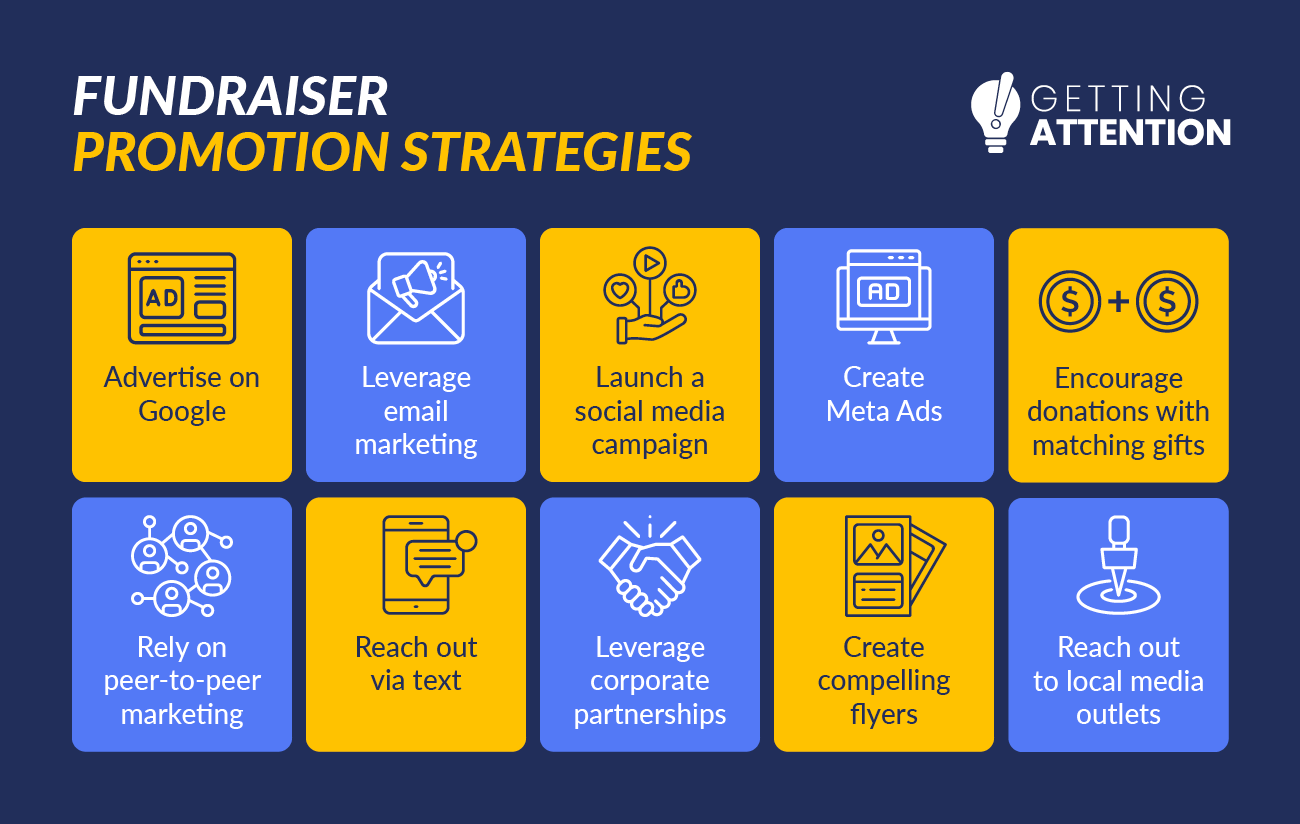
1. Advertise on Google.
Fundraising advertising is an important part of any online campaign, because digital ads can increase brand awareness by 80%. One of the best places to run ads is Google. For a majority of web users, if they have a query they want answered, they’ll turn to Google’s search engine.
Google Ads allows organizations to promote their services, products, digital fundraising campaigns, and other mission-related content in search engine results as well as non-search websites, mobile apps, and videos. Since Google owns around 90% of the global search market share, Google Ads can make a world of difference for your nonprofit.
To help nonprofits with their digital fundraising campaigns, Google offers the Google Ad Grant program. This program offers nonprofits $10,000 in Google Ad credits to spend each month on text ads. Here’s a rundown of the program:
How To Promote a Fundraiser on Google
A Google Ad Grants campaign is one of the best ways to push your digital fundraising campaigns and educational content to a targeted audience without blowing your marketing budget. To maximize your impact with this program, try the following tips:
- Know your target audience. Understand what your audience is searching for and tailor your ad copy to meet their needs. Beyond keyword selection, Google Ads offers audience targeting capabilities, so you can reach prospective donors based on location, interests, demographics, and other characteristics.
- Pick the right landing pages. Use your ads to direct users to landing pages that fulfill their needs. For instance, you might direct people searching for nonprofit volunteer opportunities to your volunteer registration page or users searching for ways to support deforestation to an optimized donation page like these nonprofits did:
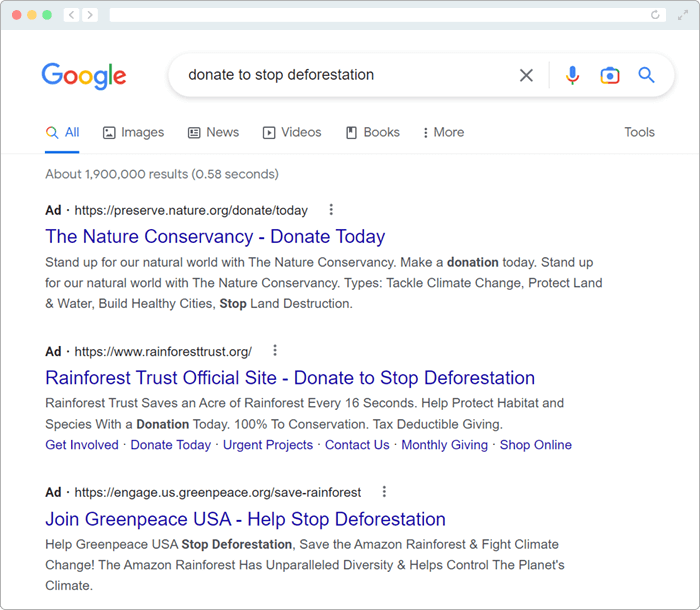
- Optimize your website. Once prospects visit your site, entice them to stay and make a gift to your digital fundraising campaign. Do so by developing professional-looking web content that positions your organization as a trustworthy steward of donations.
- Track ad campaign performance. Evaluate your fundraising advertising performance by tracking relevant data through Google Analytics, such as click-through rate and average session duration. Regularly tweak ad copy and targeting to drive traffic and clicks.
To fully maximize the Google Ad Grant for your digital fundraising campaigns, your nonprofit needs a solid understanding of digital marketing. If your team lacks expertise, consider partnering with a Google Ad Grant agency like Getting Attention to manage your campaigns, optimize content, and ensure you maximize your grant funds.
2. Leverage Email Marketing.
Email outreach generates approximately 28% of all online nonprofit revenue, making it a powerful tool for fundraiser marketing. An email series for a digital fundraising campaign will likely span weeks or months to introduce your campaign, build anticipation, and drive donations.
However, email’s popularity can also be a detriment since the average person receives up to 121 business-related emails every day.
Try these strategies to make your nonprofit’s emails stand out in donors’ inboxes:
- Personalize your messages. Emails with the recipient’s first name in the subject line have higher click-through rates than those that don’t. Use marketing tools to automatically insert names, making your outreach feel more personal (e.g., “Hello David” instead of “Dear Donor”).
- Segment your audience. Tailor your fundraising appeals based on donor history, location, or engagement level. For instance, you might tailor your donation request to suggest amounts that reflect a group of mid-level donors’ past contributions.
- Include compelling calls to action. The success of your digital fundraising campaign depends on whether supporters take action. Always include a call to action (CTA) in your outreach. Whether it’s “Donate Now” or “Register for Our Event,” make the action easy with a direct link.
To maximize success, schedule emails for fundraisers in advance. Automate personalization with email marketing tools that integrate with your CRM system to streamline outreach, improve engagement, and run a more effective digital fundraising campaign.
3. Launch A Social Media Campaign.
Whether you’re promoting an in-person event or a digital fundraising campaign, social media is essential for reaching a wide audience. When current supporters share your posts, you’ll reach their friends and family members who share similar values and are likely to contribute.
These platforms have become one of the most meaningful ways for nonprofits to engage with their supporters and release exciting news. In fact, 32% of donors are most inspired to give via social media.
With so many social media platforms out there, it can be difficult to decide where to promote a fundraiser. Carefully consider the following platforms:
- Facebook. Facebook boasts over 3 billion monthly active users, making it perfect for posting fundraiser announcements, sharing campaign updates, and inviting supporters to events by creating a Facebook Event. You can also take advantage of Facebook’s fundraising tools to add a donate button to your page and empower supporters to launch their own digital fundraising campaigns for your nonprofit.
- LinkedIn. This online professional network is a perfect place to post updates about your organization and connect with viable volunteers or employees. It’s also a great place to find potential corporate sponsors for your digital fundraising campaigns.
- Instagram. This social media platform focuses on images and short videos, both of which offer great opportunities to connect emotionally with your supporters. Develop professional and creative visual content to draw attention to your events and digital fundraising campaigns. Your followers can easily comment on your posts and interact with your Stories.
- TikTok. While a majority of Facebook and Instagram users are ages 18 to 34 and LinkedIn users are even older, TikTok users are much younger. This social media platform is perfect for connecting with Gen Z through short-form video content. There are tons of viral trends to try out, so consider sharing your nonprofit’s messages in these fun formats.
Across these platforms, use hashtags, Stories, polls, and more to drive engagement. Get creative with your content, such as by posting beneficiaries’ testimonials or behind-the-scenes footage of fundraising events.
Rather than trying to master all of these channels, we recommend focusing on the platforms where you already have a following or where supporters are active. With each post, aim to bring attention to your fundraiser and work, encouraging your audience to donate.
4. Create Meta Ads.
Meta Ads (formerly Facebook Ads and Instagram Ads, respectively) are an effective way to promote a fundraiser to a targeted audience. With billions of active users across Facebook, Instagram, and Messenger, you can tap into these platforms to drive awareness and donations for your cause. The key to success is creating compelling, targeted ads that resonate with your audience.
Here are some strategies for using Meta Ads effectively:
- Target specific audiences. Use Meta’s targeting features to narrow your audience by demographics, interests, and behaviors. For example, target people who have previously interacted with your nonprofit or shown interest in similar causes.
- Create engaging ad content. Develop ads with eye-catching visuals, videos, and powerful storytelling that connect with your audience emotionally. Make your CTA clear and direct, such as “Donate Now” or “Join Our Campaign.”
- Leverage retargeting. Meta Ads also offer the ability to retarget users who have engaged with your content but haven’t yet donated, increasing the likelihood of conversion.
Check out this example ad on Facebook for Doctors Without Borders:
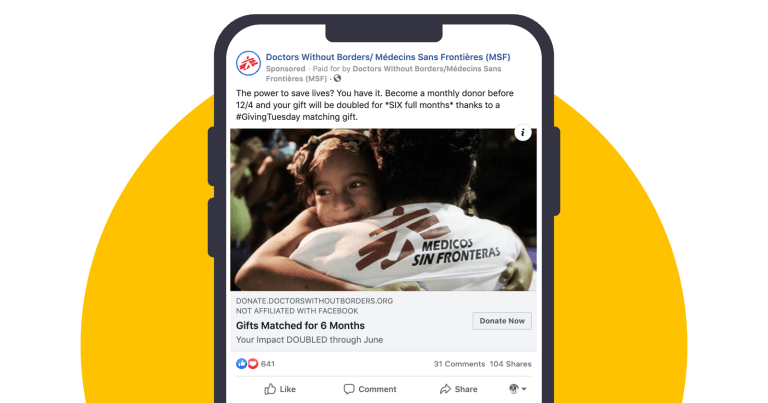
This ad was part of its GivingTuesday campaign and encouraged supporters to donate within a certain time frame to receive a match from a campaign sponsor. This fundraiser advertising campaign led to $72,000 with a 2.8x return on ad spend.
When set up correctly, Meta Ads can help expand your nonprofit’s reach, drive traffic to your donation page, and engage a larger group of potential supporters. Unlike Google Ads, Meta Ads doesn’t offer discounts to nonprofits, though.
5. Encourage Donations with Matching Gifts.
Matching gifts are a corporate philanthropy initiative in which employers financially match donations that their employees make to eligible nonprofit organizations. In a nutshell, here’s how they work:
- Someone donates to your nonprofit.
- They research their eligibility and submit a matching gift request to their employer.
- The company also donates to your nonprofit based on a fixed match rate. Companies will usually match gifts at a 1:1 (or dollar-for-dollar) ratio.
While valuable, not all eligible donors know about this opportunity! In fact, Double the Donation estimates that $6 to $10 billion in matching gift funds go unclaimed each year, primarily because of a lack of awareness.
On the bright side, roughly two to three billion dollars are donated through matching gifts annually, and there’s been an increase in companies offering matching gifts to their employees over the last three years as well, from 12% to 51%.
How To Promote A Matching Gift Fundraiser
If you want to conduct a digital fundraising campaign focused on matching gifts, either encourage donors to check their eligibility for their companies’ programs or find a sponsor for a matching donation challenge. In the latter option, a major donor or a company will promise to match any and all donations during a set time frame.
Alternatively, to encourage individuals to check into their employers’ programs, launch a matching gift awareness campaign. Here’s how to do that successfully:
- Create a dedicated matching gift page. Include all the information needed to answer the frequently asked questions your donors have. Be sure to link to your donation page to make it convenient for supporters to make a gift and have it matched.
- Bring together a matching gift team. This team will ensure that eligible gifts are matched. You might even invest in a matching gift software solution to help your team track and follow up with eligible donors.
- Incorporate matching gifts in the giving process. You can do this by embedding a searchable matching gift database into your donation page so that donors can quickly look up if their employer will match their gift.
As you incorporate matching gifts in your digital fundraising campaign, keep track of those who submit matching gifts and where they work. This can help uncover other eligible donors and ensure future matches don’t go unclaimed.
6. Rely on Supporters With Peer-to-Peer Fundraising.
Peer-to-peer fundraising leverages your supporters’ passion and energy. It’s one of the most valuable ways to promote your nonprofit’s mission and reach new prospects. In fact, nearly 40% of Americans have donated due to a friend or a family member’s request.
Here’s how this type of digital fundraising campaign works:
- Recruit passionate volunteers to fundraise on your nonprofit’s behalf.
- Set each volunteer up with a personal fundraising page, so they can collect donations and share what your organization means to them.
- Participants share their page with friends and family.
- Individuals donate to your nonprofit’s digital fundraising campaign by contributing to their loved one’s peer-to-peer page.
- Your peer-to-peer software tracks how much each fundraiser raises to make a friendly competition out of it!
- Show your appreciation by thanking your volunteers when the campaign is over.
Ensure your staff members are available to answer questions and assist volunteers so that they have a positive experience as they help you fundraise.
7. Create A Text Fundraising Campaign.
Text fundraising is a form of digital fundraising for connecting with your supporters through their most frequently used devices, their mobile devices. Donors simply text a short code or a donation amount to your organization’s assigned number. With a text fundraising tool, you can:
- Send marketing messages directly to mobile phones.
- Accept gifts through text messages.
- Thank donors who have given.
Beyond using texting as your fundraiser, you can promote other fundraisers with text marketing. Send short, impactful texts to announce events and digital fundraising campaigns they can contribute to like this:
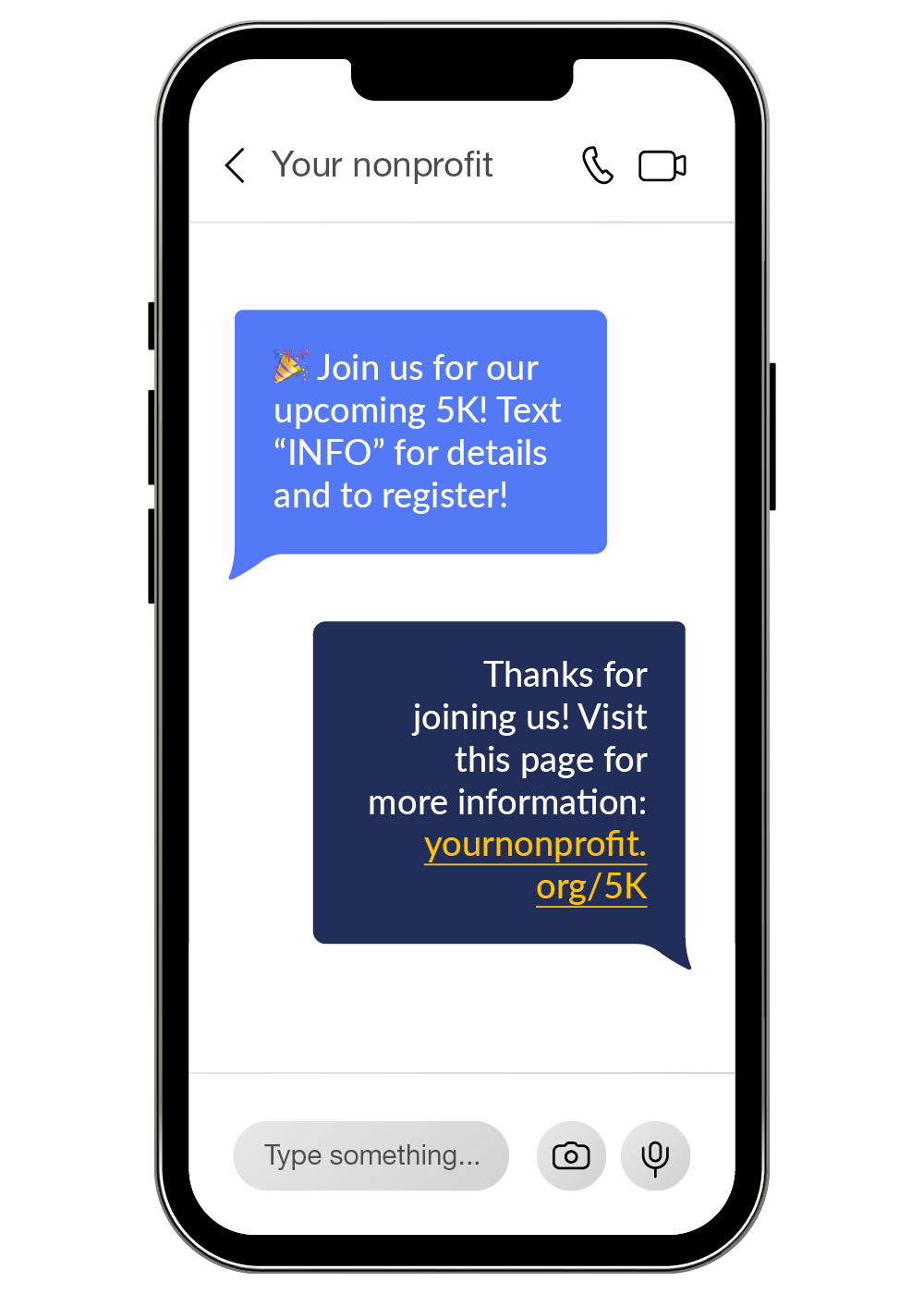
This is a valuable way to establish consistent communication. Just make sure you have their permission to send texts. You can get each donor’s preferred cell number and their confirmation to opt into texts when they sign up for opportunities.
8. Leverage Corporate Partnerships.
Your corporate partners can promote fundraisers to their employees and customers to expand your reach. They might post on social media, highlight your fundraiser in an email, or even post a flyer on a bulletin board in their storefront.
If you don’t already have corporate partners, start by identifying local businesses with similar values and audiences. For instance, an animal shelter might partner with a pet supplies store. Once you’ve established a partnership, work together on cross-promotion. Ask your partners to share your campaign across their marketing channels by featuring it in their newsletters, on social media, on their websites, or among their employees.
In return for them promoting fundraisers, offer them prominent branding opportunities at events, on your website, and across marketing materials.
9. Create Compelling Flyers
Flyers are a great way to promote a fundraiser in your local community. Design eye-catching flyers that convey key information, such as the event date, location, or how to donate. Include a strong CTA, clear contact details, and a website URL or QR code to easily contribute. Keep the design simple but impactful, using bold fonts and visuals that grab attention while conveying your message quickly.
Distribute these flyers in high-traffic areas like community bulletin boards, local businesses, and schools. You can also target previous donors by sending them in the mail.
10. Reach Out to Local Media Outlets
Media coverage can greatly expand your fundraiser’s reach. Reach out to local newspapers, radio stations, and TV stations to promote your campaign. Write a compelling press release that highlights the impact of your fundraiser and its impact.
Many local media outlets offer public service announcements (PSAs), which are free ads for organizations. Nonprofits often qualify for PSAs, especially on community radio stations, due to Federal Communications Commission (FCC) rules. Consider also working with local journalists to feature stories about your cause or upcoming event. By leveraging local media, you can promote and increase community support for your fundraiser.
Examples of Successful Fundraiser Marketing
Now that you know of the variety of strategies for promoting fundraisers, let’s take a look at some successful digital fundraising campaigns. Fundraisers can take a variety of shapes, and you can create successful campaigns by learning lessons from other great marketing and advertising examples.
These concrete examples will show you how to promote a fundraiser like yours.
1. ALS Ice Bucket Challenge
The ALS Ice Bucket Challenge went viral in 2014. It challenged participants to pour a bucket of ice water over their heads to promote awareness of amyotrophic lateral sclerosis (ALS) and encourage donations to research associations. The ALS Ice Bucket Challenge allowed the ALS Association to increase its annual funding for research around the world by 187%, and it was all thanks to effective fundraiser marketing.
The success of the ALS Ice Bucket Challenge was driven by its clever marketing strategy, which leveraged social media and user-generated content to create a viral movement. By encouraging participants to challenge their friends, the campaign spread quickly, generating massive visibility while encouraging donations through a fun experience.
2. The Red Cross’s Haiti Earthquake Relief Effort
The Red Cross held this digital fundraising campaign in 2010 to help Haitians affected by the earthquake by providing food, water, shelter, medical care, and other essentials. This campaign implemented a text fundraising strategy by asking supporters to “Text HAITI to 90999” to donate $10. The Red Cross raised tens of millions of dollars to help more than 4.5 million Haitians, making this digital fundraising campaign a huge success.
The Red Cross’s Haiti Earthquake relief campaign capitalized on the convenience of mobile giving, making it easy for people to donate directly from their phones. The campaign’s use of high-profile media coverage and celebrity endorsements further amplified its reach, encouraging widespread participation and rapid fundraising support.
3. Children’s Miracle Network Hospitals’ Extra Life Campaign
The Extra Life campaign is an annual digital fundraising event held by the Children’s Miracle Network Hospitals. Participants sign up to play games from home or online and ask friends and family to donate in support. There are Game Days every year, and the funds raised go towards helping children get the medical care they need.
The Extra Life campaign is effectively marketed through a combination of social media engagement, influencer partnerships, and gaming community outreach. The nonprofit even offers a charity stream toolkit, such as stream overlays, flyers, and graphics. By tapping into the gaming culture and encouraging participants to share their fundraising efforts, the campaign has successfully built a dedicated and growing community of supporters.
Additional Resources for Promoting Fundraisers
If you’re looking to boost your fundraising efforts, engage your supporters, and reach new prospects, learning how to promote a fundraiser is key. Don’t just rely on sharing your donation page for a digital fundraising campaign. Use the strategies outlined above to amplify your fundraiser and create lasting connections with your audience.
To continue becoming an even better fundraiser, explore these free resources about marketing:
- Google Ad Grant Impact: Capturing Results and Measuring ROI. Learn more about the impact that the Google Ad Grant program can make on your nonprofit’s fundraiser marketing.
- Facebook Challenges: Social Media Fundraising for Nonprofits. Lean into the power of social media and read about how Facebook Challenges can strengthen your nonprofit’s digital fundraising promotion.
- 15+ Nonprofit Marketing Software Tools To Spread Awareness. Explore several helpful tools that will make promoting fundraisers a breeze.
